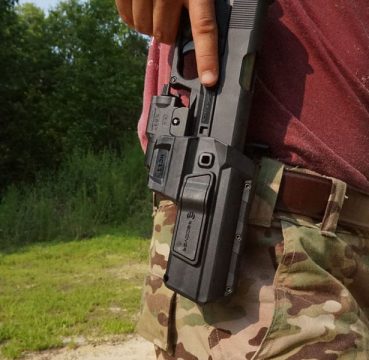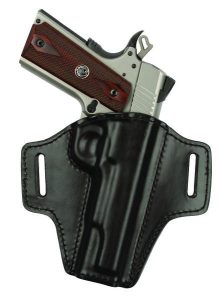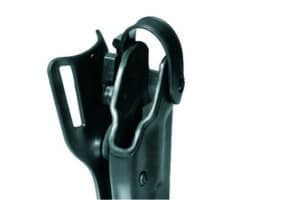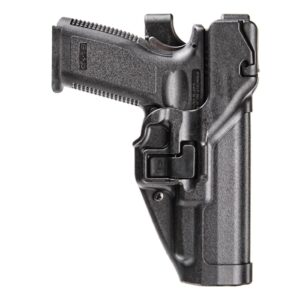If you’re in the market for a handgun holster, you might have noticed the words “Level II retention” on listings. Handgun retention sounds like a good thing, especially if you’re an active person who wants to carry a firearm all the time. But you’re also carrying for defense, so does more retention equal a longer draw time?
Table Of Contents
Why is Firearm Retention Important?
You might be wondering what’s the big deal with handgun retention. Well, if you plan to carry everyday, you need to be aware of situations that might make your pistol fall from its holster. Say you went to the grocery store. Simple, right? Something you probably do once a week.
Keep in mind that actions like bending over to pick up a case of soda or a bag of dog food from the bottom of your cart might result in your handgun dislodging. Not only do you want to protect your expensive investment, but it’s your responsibility to ensure that your concealed handgun stays concealed.
Also, consider that you’re carrying your firearm for personal protection and think about a situation in which an assailant gets close enough to draw your weapon and use it on you. Increasing your handgun retention also increases your draw time. You should always practice with a holster to make sure you are proficient in its use.
What do you really know about handgun holster retention levels? Don’t worry if your answer is “not much”. Let’s look at the differences in retention levels that you might come across in your search for a quality holster.
Passive versus Active Retention
Many holsters feature a passive retention option. These are usually made of polymer, but some leather holsters are precision molded and offer some retention. There are also nylon holster,s like those made by Sticky Holsters, which have their own passive retention in the form of friction. Polymer holsters can come with adjustable retention screws to guarantee a tight fit to your firearm.
Active retention refers to a holster that has some form of retention the wearer must activate in order to draw the weapon. This may include a retention strap with a thumb break or a button the user must push with a finger or thumb. There are a total of four handgun retention levels for holsters on the market today.
But, there can be some confusion when talking about retention holsters, as some manufacturers use a Level 0 retention holster to be those utilizing simple passive retention (usually called Level 1 retention), thereby bumping a Level 2 retention down to a Level 1.
Level 1 Retention
Most instructors and holster manufacturers will call a passive retention holster a Level I. As previously discussed, these holster use molding or friction to keep the firearm in the holster. They won’t have any straps, snaps, buttons, flaps, or other means of securing the firearm to the holster.
Polymer Level 1 holsters will usually have a trigger guard that snaps into place when the firearm is holstered. They will give off an ‘audible click’ so the wearer knows the retention mechanism has secured the weapon.
These are sometimes called a Level 0 holster, creating some confusion when searching listings for holsters. Level 1 retention holsters are often in the lower price range, since there aren’t as many bells and whistles included with them.
An example of a level 1 retention holster is the Bianchi Model 126 Assent Holster.
Level II Retention
This is the minimum safe holster type for law enforcement and military personnel. These holsters have some device, often a retention strap, that requires the user to perform an action before the firearm will draw from the holster.
In leather or nylon, the holster will have a strap that goes over the back of the firearm to secure it in place. The user must use a thumb to release the snap, thereby releasing the weapon.
Another type of Level II holster is the polymer holster with a finger button. To release the weapon, the user must assume what’s called the ‘master grip’ and activate the button with a finger or thumb.
These holsters can be drawn from quickly with a little practice by the wearer. An example of a Level II retention holster is the Model 6001 Sentry-Self Locking holster by Safariland.
Level III Retention
This is the highest level of retention common in handgun holsters. They combine the features above along with requiring a push, pull, or rotation by the wearer in order to draw the weapon. These holsters make it almost impossible for an assailant to remove the firearm, even if the wearer is unconscious.
A Level III retention holster does require a bit of practice on the part of the wearer to ensure a quick, smooth draw. Most average concealed carry wearers won’t need or require this level of retention. It’s seen more often in law enforcement, military, and private security use.
These holsters are often more expensive due to craftsmanship and extra retention features. One example of a Level III retention holster is the Blackhawk SERPA Level III Duty Holster.
Level IV Retention
As with the other levels of retention, this one is a step beyond the Level III retention. In fact, a level IV retention holster isn’t recommended for the average armed citizen due to the difficulty in learning to use it.
This holster will have three active retention devices combined with passive retention. If you want to check out a Level IV retention holster, you can watch this video:
Choosing a retention holster is a big deal, and depends on numerous factors, including how you plan to carry your firearm. For the average concealed carry user, a Level I or Level II holster will probably be sufficient. However, if you’re involved in law enforcement or private security, you’ll probably want to pick up a level III holster.
Recommended Reading
Five Best Glock Holsters for Concealed Carry















